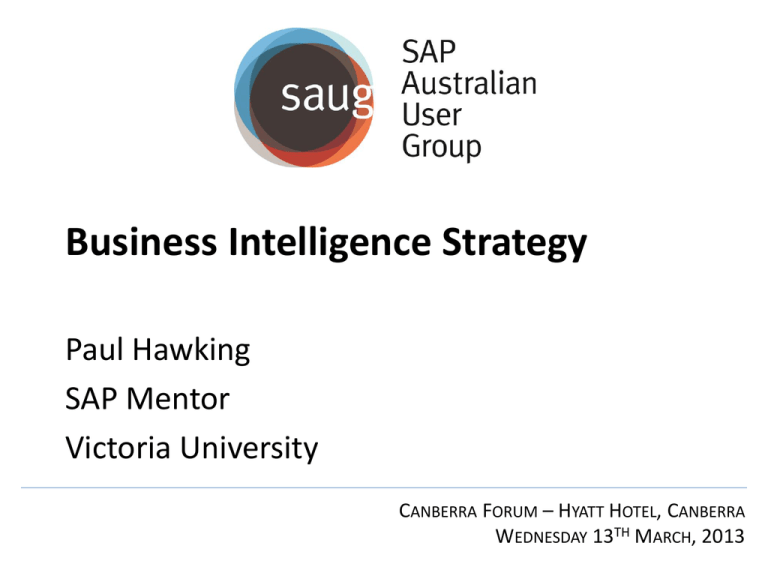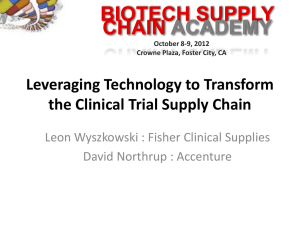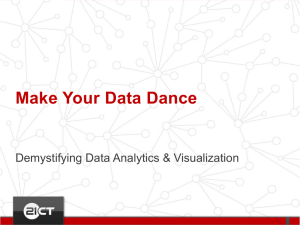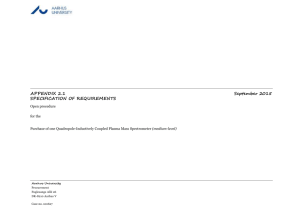SAUG Canberra BI Strategy - Business
advertisement

Business Intelligence Strategy Paul Hawking SAP Mentor Victoria University CANBERRA FORUM – HYATT HOTEL, CANBERRA WEDNESDAY 13TH MARCH, 2013 Background SAP University Alliance Program (UAP) University SAP SAP User Group SAP Academic Program Director SAP Mentor Presenter Teach Academics Design Events Research Develop curriculum Advisor Industry Reports Past Chairperson Best selling author ERP Systems and Business Intelligence Top 10 Most Influential SAP People (InsideSAP) Visiting Professor Who has a BI Strategy? Is somebody responsible for its success? Business Intelligence Does it contain metrics? Is the BI Strategy written down? Maximise Value From ERP Systems 1. Likely to seek and measure tangible benefits, such as reduced cost and increased revenue. 2. Emphasis on integrating, optimizing and using analytics to drive improved business performance. 3. Extend systems throughout their organization and implement across a range of functions. 4. Integrate the organization and external systems of customers and suppliers. 5. Aggressively use information and analytics to improve decision making. Top CEO Business Priorities, 2013 Rank Top 10 Business Priorities 1 Increasing enterprise growth 2 Reducing enterprise costs 3 Expanding into new markets and geographies 4 Increase profitability 5 Implementing finance and controls 6 Talent and workforce management/development 7 Consolidating, standardizing and streamlining operations Execute acquisitions, mergers and partnerships 8 9 Improve governance, risk, compliance and security Gartner Strategy and Business Intelligence Business Transformation Projects Implement strategy through process, then continuously improve process effectiveness and efficiency Strategy & Business Requirements Business Process Priorities Customers Corporate Governance Business Strategy Customer CustomerManagement Management Initiate Business Transformation Business Control & Finance Business Transformation Projects Toll gates & Deliverables Product Product Creation Creation Product Product Life Life Cycle Cycle Communications Order Order Fulfilment Fulfilment Capital Capital Equipment Equipment Order Order Fulfilment Fulfilment Packaging Packaging Material Material Order Order Fulfilment Fulfilment Service Service Products Products Analyse Potential value Fit with strategic priorities Design Plan As-Is description with f act base To-be description of new approach Initiative KPI and Baseline Stakeholder input Project Charter Financial Potential Develop Conf irmed Implementation plan (Cluster) Implement Pilot evaluation PM and SG Leadership and resource plan Milestone completion Solution ready to implement Business Case High-Level Business Case Conf irmed Business Case Benef it verif ication High-Level Implementation Plan Legal & Tax Human Resources Supplier SupplierManagement Management Information Technology Suppliers = Performance GLT member x Processes GLT member GLT member T Council x People Tools GLT member T Council • Non aligned strategy with corporate strategy •• •• • •• • •• •• Littlemessages up front investment Key Journey with on business Limited impact from data accenture Ice burg Reactive reporting Maturity BI silo and governance Success Edw Organic growth Complexity Business Role of BI (TWDI) Prediction Monitoring Analysis • Why did it happen? • What’s happening now? Reporting • What happened? Business Value • What might happen? Why Act? No documented information strategy Incomplete information with limited ability to drill down to support detail Strategy Unaligned, diverse data structures Different definitions used across the business Information Requirements Data Management Operating Model Information Access Solution Architecture Reliance on Excel and manual processes to produce data Multiple point solutions with minimal integration Poorly integrated processes with areas of duplication and inefficiency Limited flexibility, absence of consistent data management Complex transformations of non standard source data Time spent on validation and reconciliation rather analysis • Where are we now? • Where would we like to go? • How do we get there? Where are we now? Where are we now? ASUG Business Intelligence Maturity Model Stage Information and Analytics 1 2 3 4 Information Dictatorship Information Anarchy Information Dictatorship Information Collaboration Requirements are driven from a limited executive group KPI’s and analytics are identified, but not well used KPI’s and analytics are identified and effectively used KPI’s and analytics are used to manage the full value chain IT driven BI Business driven BI evolving BI Competency Centre developing Enterprise wide BI governance with business leadership Do not exist or are not uniform Evolving effort to formalise Exist and are not uniform Uniform, followed and audited BI “silos” for each business unit Some shared BI applications Consolidating and upgrading Robust & flexible BI architecture Governance Standards and processes Application Architecture Measuring BI Success and Value (McDonald 2004) • • • Create a formal, continuous process for measuring success and value generated Identify and measure results of each project phase Establish realistic goals and expectations based on capability / maturity Value Created Operational Success User Success Implementation Success • • • • • Productivity improvements • Process efficiency and effectiveness • Key performance indicators User adoption Usage tracking User satisfaction Data problems • On-time, On-budget Overall Success of the BI Initiative Business Success • Return on investment • Economic value add • Revenue increases • Cost Savings • Customer / corporate profits • Enables Business Strategy and Completive Advantage BI Effectiveness Scorecard Measure Score Comment Business Case & Vision 1) Single source of truth, 2) business analysis across borders, processes, businesses, 3) Analysts move from data gathering to real business analysis, 4) reduce total reporting cost Executive support CFO provides visible public support Alignment to business strategy and business processes Only Global Business Process Owners can request BI or CPM projects Alignment and working practices – Business and IT Business Transformation Process aligns strategy, process and organisation. Business owns scope prioritisation and outcomes Extended BI CC Central team with both business and technical expertise. Network from the center Business Transformation Officers and Market MIS Coordinators provide the link to adoption Predictability – robust and effective delivery methodology Compliance to IT Project and Service processes as a subset of Business Transformation process TBI Value Scorecard Measure Score Comment Global Enterprise-wide Adoption – the ultimate measure of BI success – % of employees as active BI users > 10% More than 10% of employees are active users, expect to reach 15% in 2009. More than 30000 navigations per day. 20% of employees are registered users. % coverage in BI of business processes and business performance measurements 100% Business performance measurements are available for all business processes and all business units. Expanding coverage within processes and units. Used in all Markets and in the center. 5 seconds Worldwide: all management reports in 15 seconds or less, average navigation step below 5 seconds Single source of truth across borders, processes, businesses Response time Reliability, Consistency & Quality Easy to use – low training cost Enables next steps – new major business information initiatives 7AM All managers have fresh data at 7AM their time worldwide. Information is correct and broadening. Adoption makes sure it stays correct. High user adoption Information portal based on geography, business roles and business processes; standard layouts make it easy to understand and use Global Information Projects Successful major new information projects – brand information back to our customers, worldwide alignment on Sales Forecasting FIVE KEY AREAS OF STRATEGY Assuming you need a BI strategy, or to update an existing one, there are five key areas of consideration: 1. BI Roadmap – for use as a start-up to a BI strategy implementation project. 2. Stakeholder Management - getting the right people involved at the right level. 3. Architectural Blueprint - how the BI estate will look and operate. 4. Capability Improvement - what needs upgrading, redeveloping or decommissioning 5. Implementation Planning - how to approach implementing the roadmap to take you from here to there. If It’s All Too Hard Report Analysis 1. What actions occur as a result of the report? 2. If no actions why not? 3. Under what circumstances will an action occur? 4. Modify the report to be actionable 5. Understand the decision workflow Meta Data Data Integration Master Data BICC Data Quality BI Strategy Executive Support Skills Paul Hawking SAP Academic Programs Director College of Business Telephone: +61-3-99194031 Mobile: +61-419301628 Email Paul.Hawking@vu.edu.au Paulhawking #SAPVU Gartner Maturity Model Level 1: Unaware Level 2: Tactical • Total Lack of Awareness • Spreadsheet and Information Anarchy • One-off Report Requests • What to do: • Identify the business drivers • Get commitment and resources • Understand the data sources, data quality, architecture and systems • • No Business Sponsor, IT executive in charge Limited Users - mainly managers and executives Data Inconsistency and stove-piped systems What to do: • Get funding for finance related BI initiatives from senior executives • Define metrics to analyze specific departmental or functional performances • Find out requirements for dashboards • Make case for BI Competency center Gartner Maturity Model Level 3: Focused Level 4: Strategic • • • • • Funding from business units on a project-byproject basis Specific set of users is realizing value Successful focus on a specific business need BI Competency Center in place • • • What to do: • Increase BI initiative scope across multiple departments • Find BI investment and commitment for nonfinancial data such as sales and product • Look for integrating the data and consolidate disparate analytic applications • Create an enterprise wide metrics framework • Expand the user base Establish a balanced portfolio of standards Business objectives drive BI and performance management systems Deploy an Enterprise metrics framework Governance policies are defined and enforced What to do: • Look to extend the BI application to supplies, customers and business partners • Determine how to use BI to support evolving business objectives and strategy • BICC should look at integrating BI Analytics with the business processes Gartner Maturity Model Level 5: Pervasive • • • Use of BI is extended to suppliers and customers Analytics are inserted into and around the business processes Information is trusted across the company










